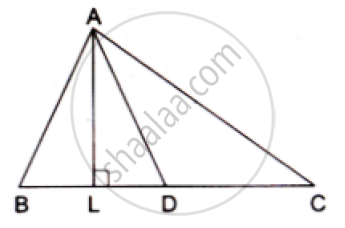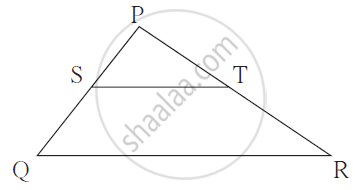Advertisements
Advertisements
Question
In a ABC , AD is a median and AL ⊥ BC .

Prove that
(a) `AC^2=AD^2+BC DL+((BC)/2)^2`
(b) `AB^2=AD^2-BC DL+((BC)/2)^2`
(c) `AC^2+AB^2=2.AD^2+1/2BC^2`
Solution 1
(a) In right triangle ALD
Using Pythagoras theorem, we have
`=AC^2-AL^2+LC^2`
`=AD^2-DL^2+(DL+DC)^2 ` [Using (1)]
=`AD^2-DL^2+(DL+(BC)/2)^2` [∵ AD is a median]
`=AD^2-DL^2+DL^2+((BC)/2)^2+BC.DL `
∴` AC^2=AD^2+BC.DL+((BC)/2)^2` .................(2)
(b) In right triangle ALD
Using Pythagoras theorem, we have
`AL^2=AD^2-DL^2` ....................(3)
Again, In right triangle ABL
Using Pythagoras theorem, we have
`AB^2=AL^2+LB^2`
`=AD^2-DL^2+LB^2` [𝑈𝑠𝑖𝑛𝑔 (3)]
Solution 2
(a) In right triangle ALD
Using Pythagoras theorem, we have
`=AC^2-AL^2+LC^2`
`=AD^2-DL^2+(DL+DC)^2 ` [Using (1)]
=`AD^2-DL^2+(DL+(BC)/2)^2` [∵ AD is a median]
`=AD^2-DL^2+DL^2+((BC)/2)^2+BC.DL `
∴` AC^2=AD^2+BC.DL+((BC)/2)^2` .................(2)
(b) In right triangle ALD
Using Pythagoras theorem, we have
`AL^2=AD^2-DL^2` ....................(3)
Again, In right triangle ABL
Using Pythagoras theorem, we have
`AB^2=AL^2+LB^2`
`=AD^2-DL^2+LB^2` [𝑈𝑠𝑖𝑛𝑔 (3)]
=`AD^2-DL^2+(BD-DL)^2`
=`AD^2DL^2+(1/2BC-DL)^2`
=`AD^2-DL^2+((BC)/2)^2-BC.DL+DL^2`
∴ AB^2=AD^2-BC.DL+((BC)/2)^2 .............(4)
(c) Adding (2) and (4), we get,
=`AC^2+AB^2=AD^2+BC.DL+((BC)/2)^2+AD^2-BC.DL+((BC)/2)^2`
=`2AD^2+(BC^2)/4+(BC^2)/4`
=`2AD^2+(BC^2)/4+(BC^2)/4`
=`2AD^2+1/2BC^2`
APPEARS IN
RELATED QUESTIONS
In ΔABC, D and E are points on the sides AB and AC respectively such that DE || BC
If AD = 6 cm, DB = 9 cm and AE = 8 cm, find AC.
In ΔABC, D and E are points on the sides AB and AC respectively such that DE || BC
If AD = 4x − 3, AE = 8x – 7, BD = 3x – 1 and CE = 5x − 3, find the volume of x.
D and E are the points on the sides AB and AC respectively of a ΔABC such that: AD = 8 cm, DB = 12 cm, AE = 6 cm and CE = 9 cm. Prove that BC = 5/2 DE.
ΔABC is an isosceles triangle with AB = AC = 13cm. The length of altitude from A on BC is 5cm. Find BC.
In the given figure, D is the midpoint of side BC and AE⊥BC. If BC = a, AC = b, AB = c, AD = p and AE = h, prove that
(i)`B^2=p^2+ax+a^2/x`
(ii)` c^2=p^2-ax+a^2/x`
(iii) `b^2+c^2=2p^2+a^2/2`
(iv)`b^2-c^2=2ax`


In Δ PQR, points S and T
are the midpoints of sides PQ
and PR respectively.
If ST = 6.2 then find the length of QR.
In ΔABC, AB = 6 cm and DE || BC such that AE = `1/4` AC then the length of AD is ______.
O is the point of intersection of the diagonals AC and BD of a trapezium ABCD with AB || DC. Through O, a line segment PQ is drawn parallel to AB meeting AD in P and BC in Q. Prove that PO = QO.
Construct an equilateral triangle of side 7 cm. Now, construct another triangle similar to the first triangle such that each of its sides are `5/7` times of the corresponding sides of the first triangle.
Prove that If a line is drawn parallel to one side of a triangle to intersect the other two sides in distinct points, the other two sides are divided in the same ratio. In the figure, find EC if `(AD)/(DB) = (AE)/(EC)` using the above theorem.

